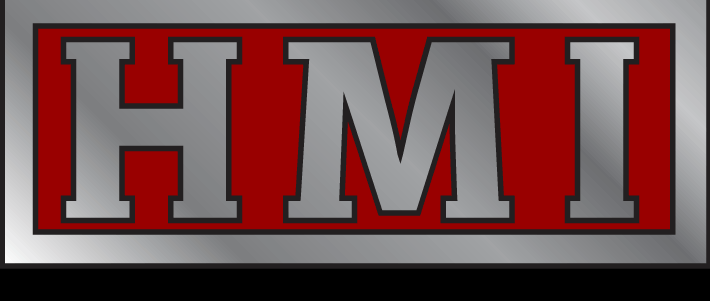Bed Buster Standard (5 Blades) Manual
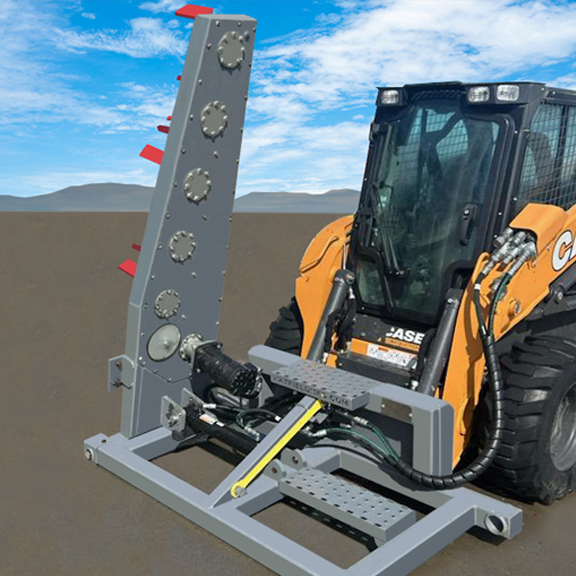
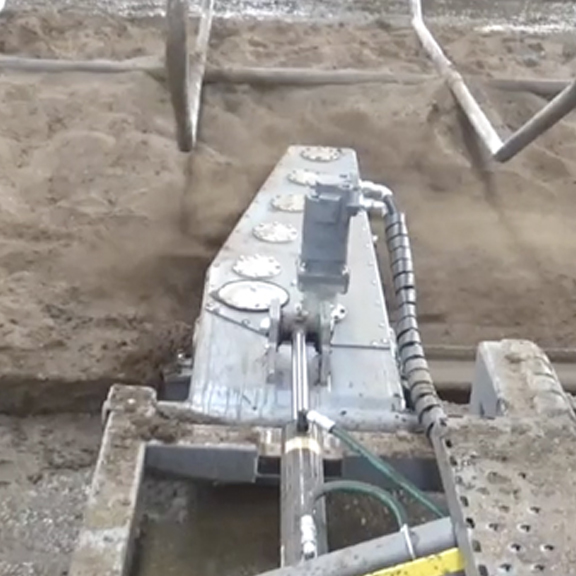
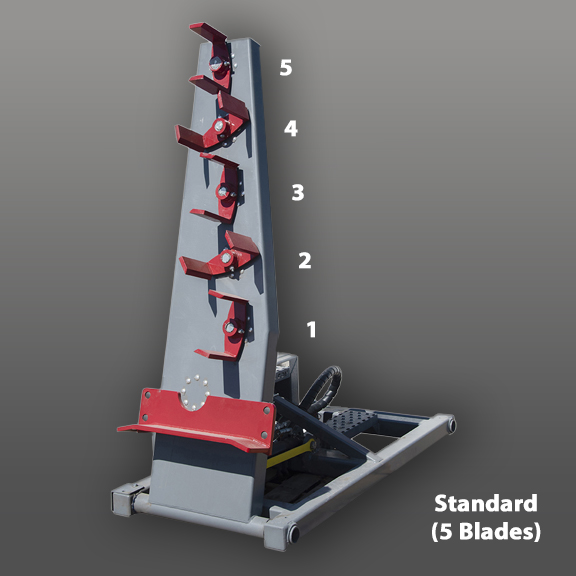
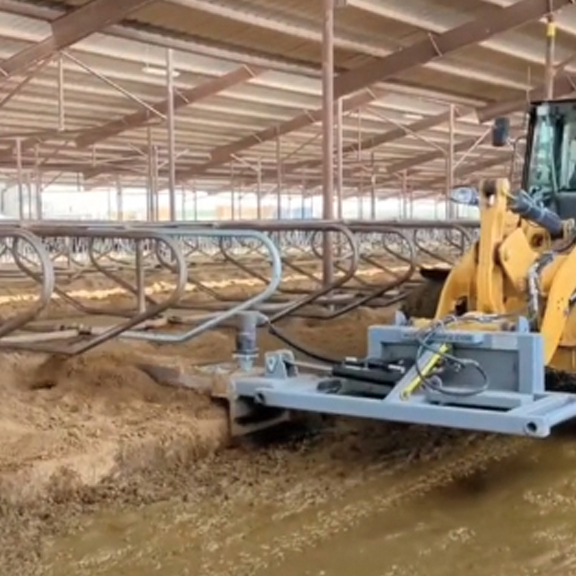
Listed below are common practices that may or may not be applicable to the products described in this manual.
Look for the Safety Alert Symbol
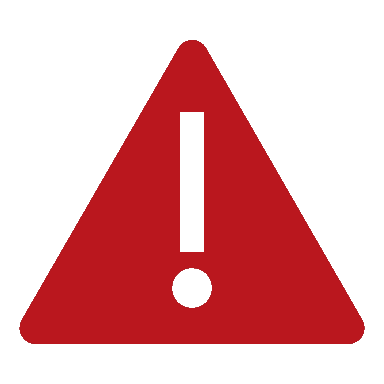
The SAFETY ALERT SYMBOL indicates there is a potential hazard to personal safety and extra precaution must be taken. When you see this symbol, be alert and carefully read the message that follows it. Hazard control, and accident prevention are dependent upon the awareness, concern, prudence and proper training of personnel involved in the operation, transport, maintenance, and storage of equipment.
Be Aware of Signal Words
A signal word designates a degree or level of hazard seriousness. They are:
DANGER:
Indicates a hazardous situation that, if not avoided, will result in death or serious injury.
WARNING:
Indicates a hazardous situation that, if not avoided, could result in death or serious injury.
Listed below are common practices that may or may not be applicable to the products described in this manual.
Safety at All Times
Careful operation is your best assurance against an accident. All operators, no matter how much experience they may have, should carefully read this manual and other related manuals before operating this power machine and this implement.
- Thoroughly read and understand the “Safety Label” section. Read all instructions noted on them.
- Do not operate the equipment while under the influence of drugs or alcohol as they impair the ability to safely and properly operate the equipment.
- The operator should be familiar with all functions of the power machine and attached implement, and be able to handle emergencies quickly.
- Keep all bystanders away from equipment and work area.
- Operate power machine and controls from the driver’s seat only.
- Never dismount from a moving power machine or leave power machine unattended with engine running.
- Do not allow anyone to stand between implements and power machine while attempting to connect or disconnect them.
- Keep hand, feet and clothing away from power-driven parts.
- While transporting and operating equipment, watch out for objects overhead and along side such as fences, trees, buildings, wires, etc.
- Do not turn power machine so tight as to cause hitched implement to contact the power machine’s rear wheel.
- Store implement in a safe and secure area where children do not plate. When needed, secure implement against falling with support blocks and/or shipping locks.
Safety Precautions for Children
Tragedy can occur if the operator is not alert to the presence of children. Children are generally attracted to implements and their work.
- Never assume children will remain where you last saw them.
- Keep children out of the work area and under the watchful eye of a responsible adult.
- Be alert and shut the implement and power machine down if children enter the work area.
- Never carry children on the power machine or implement. There is not a safe place for them to ride. They may fall off and be run over or interfere with the control of the power machine.
- Never allow children to operate the power machine, even under adult supervision.
Power Machine Shutdown & Storage

- If engaged, disengage power take-off.
- Park on solid, level ground and lower implements to ground or onto support blocks.
- Put power machine in part or set park brake
- Turn off engine and remove ignition key to prevent unauthorized starting.
- Relieve all hydraulic pressure to auxiliary hydraulic lines.
- Wait for all components to stop before leaving the operator’s seat.
- Use steps, grab-handles and anti-slip surfaces when stepping on and off the power machine.
Use a Safety Chain
- A safety chain will help control drawn machinery should it separate from the power machine or tow vehicle.
- Use a chain with the strength rating equal to or greater than the gross weight of the towed implement
- Attach the chain to the power machine’s or tow vehicle’s draw bar support or other specified anchor location. Allow only enough slack in the chain to permit turning.
- Always hutch the implement to the machine towing it. Do not use the safety chain to tow the implement.
Tire Safety
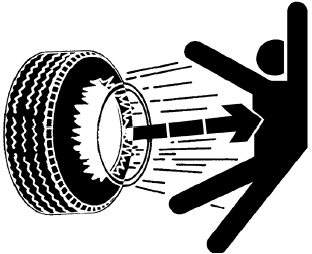
- Tire changing can be dangerous and must be performed by trained personnel using the correct tools and equipment.
- Always properly match the wheel size to the properly sized tire.
- Always maintain correct tire pressure. Do not inflate tires above the recommended pressures shown in the Operator’s Manual or printed on the tires themselves.
- When inflating tires, use a clip-on chuck and extension hose long enough to allow you to stand to one side and NOT in front of or over the tire assembly. Use a safety cage if available.
- Securely support the implement when changing a wheel.
- When removing and installing wheels, use wheel handling equipment adequate for the weight involved.
- Make sure wheel bolts have been tightened to the specified torque.
Practice Safe Maintenance
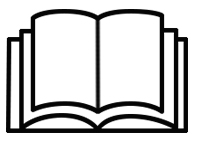
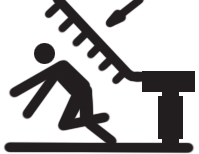
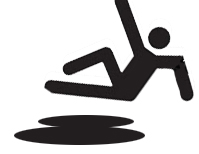
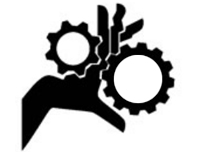
- Understand procedure before doing work. Refer to the Operator’s Manual for additional information.
- Work on a level surface in a clean, dry area that is well-lit.
- Lower implement to the ground and follow all shutdown procedures before leaving the operator’s seat to perform maintenance
- Do not work under any hydraulically supported equipment. It can settle, suddenly lead down, or be lowered accidentally. If it is necessary to work under the equipment, securely support it with stands or suitable blocking beforehand.
- Use properly grounded electrical outlets and tools.
- Use correct tools and equipment for the job that are in good condition.
- Allow equipment to cool before working on it.
- Disconnect battery ground cable (-) before servicing or adjusting electrical systems or before welding on implement.
- Inspect all parts. Make certain parts are in good condition & installed properly.
- Replace parts on this implement with genuine Hatfield parts only. Do not alter this implement in a way which will adversely affect its performance.
- Do not grease or oil implement while it is in operation.
- Remove any buildup of grease, oil, and/or debris.
- Always make sure any material and waste products from the repair and maintenance of the implement are properly collected and disposed.
- Do not weld or torch galvanized metal as it will release toxic fumes.
Prepare for Emergencies
- Be prepared if a fire starts
- Keep a first aid kit and fire extinguisher handy.
- Keep emergency number for doctor, ambulance, and fire department near the phone.
Use Safety Lights and Devices
- A slow-moving power machine can create a hazard when driven on public roads. They are difficult to see, especially at night. Use the Slow-Moving Vehicle (SMV) Sign when on public roads.
- Flashing warning lights and turn signals are recommended whenever driving on public roads.
Wear Personal Protective Equipment
- Wear protective clothing and equipment appropriate for the job such as safety shoes, safety glasses, hard hat, dust mask, and ear plugs.
- Clothing should fit snug without fringes and pull strings to avoid entanglement with moving parts.
- Prolonged exposure to loud noise can cause hearing impairment or hearing loss. Wear suitable hearing protection such as earmuffs or earplugs.
- Operating a machine safely requires the operator’s full attention. Avoid wearing headphones while operating
Use Seat Belt and ROPS
- Use of a CAB or roll-over-protective-structures (ROPS) and seat belt is recommended in almost all power machines.
- If ROPS is in the locked-up position, fasten seat belt snugly and securely to help protect against serious injury or death from falling and machine overturn.
Avoid High Pressure Fluids
- Escaping fluid under pressure will penetrate the skin or eyes causing serious injury.
- Relieve all residual pressure before disconnecting hydraulic lines or performing work on the hydraulic system.
- Make sure all hydraulic fluid connections are properly tightened/torqued and all hydraulic hoses and lines are in good condition before applying pressure to the system.
- Use a piece of paper or cardboards, NOT BODY PARTS, to check for suspected leaks.
- Wear protective gloves and safety glasses or goggles when working with hydraulic systems.
- DO NOT DELAY. If an accident occurs, seek immediate
Keep Riders Off Machinery
- Never carry riders on the tractor or implement.
- Riders obstruct operator’s view and interfere with the control of the power machine.
- Riders can be struck by objects or thrown from equipment.
- Never use the power machine to lift or transport riders.
Avoid Crystalline Silica (quartz) Dust
Because crystalline silica is a basic component of sand and granite, many activities at construction sites produce dust containing crystalline silica. Trenching, sawing and boring of material containing crystalline silica can produce dust containing crystalline silica particles. This dust can cause serious injury to the lungs (silicosis).
There are guidelines which should be followed if crystalline silica (quartz) is present in the dust.
- Be aware of and follow OSHA (or other local, State, or Federal) guidelines for exposure to airborne crystalline silica.
- Know the work operations where exposure to crystalline silica may occur.
- Participate in air monitoring or training programs offered by the employer.
- Be aware of and use optional equipment controls such as water sprays, local exhaust ventilation, and enclosed cabs with positive pressure air conditioning if the machine has such equipment. Otherwise, respirators shall be worn.
- Where respirators are required, wear a respirator approved for protection against crystalline silica containing dust. Do not alter respirator in any way. Workers who use tight-fitting respirators can not have beards/mustaches which interfere with the respirator seal to the face.
- If possible, change into disposable or washable work clothes at the work side; shower and change into clean clothing before leaving the work site.
- Do not eat, drink, use tobacco products, or apply cosmetics in areas where there is dust containing crystalline silica.
Handle Chemicals Properly
- Protective clothing should be worn.
- Handle all chemicals with care.
- Follow instructions on container label.
- Agricultural chemicals can be dangerous. Improper use can seriously injure persons, animals, plants, soil, and property.
- Inhaling smoke from any type of chemical fire can be a health hazard.
- Store or dispose of unused chemicals as specified by the chemical manufacturer.
Dig Safe — Avoid Underground Utilities
- USA: Call 811. CAN: digsafecanada.ca Always contact your local utility companies (electrical, telephone, gas, water, sewer, and others) before digging so that they may mark the location of any underground services in the area.
- Be sure to ask how close you can work to the marks they positioned.
Transport Safely
- Comply with federal, state and local laws.
- Use towing vehicle and trailer of adequate size and capacity. Secure equipment towed on a trailer with tie downs and chains
- Sudden braking can cause a towed trailer to swerve unexpectedly. Reduce speed if towed trailer is not equipped with brakes.
- Avoid contact with any overhead utility lines or electrically charged conductors.
- Always drive with load on end of loader arms low to the ground.
- Always drive straight up and down steep inclines with heavy end of skid steer on the “uphill” side
- Maximum transport speed for an attached equipment is 20 mpg (32km/h). DO NOT EXCEED
- As a guideline, use the following maximum speed weight ratios for attached equipment: 20 mph (32 km/h) when weight of attached equipment is less than or equal to the weight of the tow vehicle. 10 mph (16 km/h) when weight of attached equipment exceeds the weight of the tow vehicle but not more than double the weight.
- IMPORTANT: Do not tow a load that is more than double the weight of the vehicle towing the load.
Safety Labels
Your Bed Buster comes equipped with all safety labels in place. They were designed to help you safely operate your equipment. Read and follow their directions.
- Keep all safety labels clean and legible.
- Refer to this section for proper label placement. Replace all damaged or missing labels. Order new labels from www.hatfieldmfg.com.
- Some new equipment installed during repair requires safety labels to be affixed to the replaced component as specified herein. When ordering new components make sure the correct safety labels are included in the request.
- Refer to this section for proper label placement. To install new labels: Clean Surface area where label is to be placed. Spray soapy water onto the cleaned area. Peel backing from label and press label firmly onto the surface. Squeeze out air bubbles with edge of a credit card or with a similar type of straight edge.
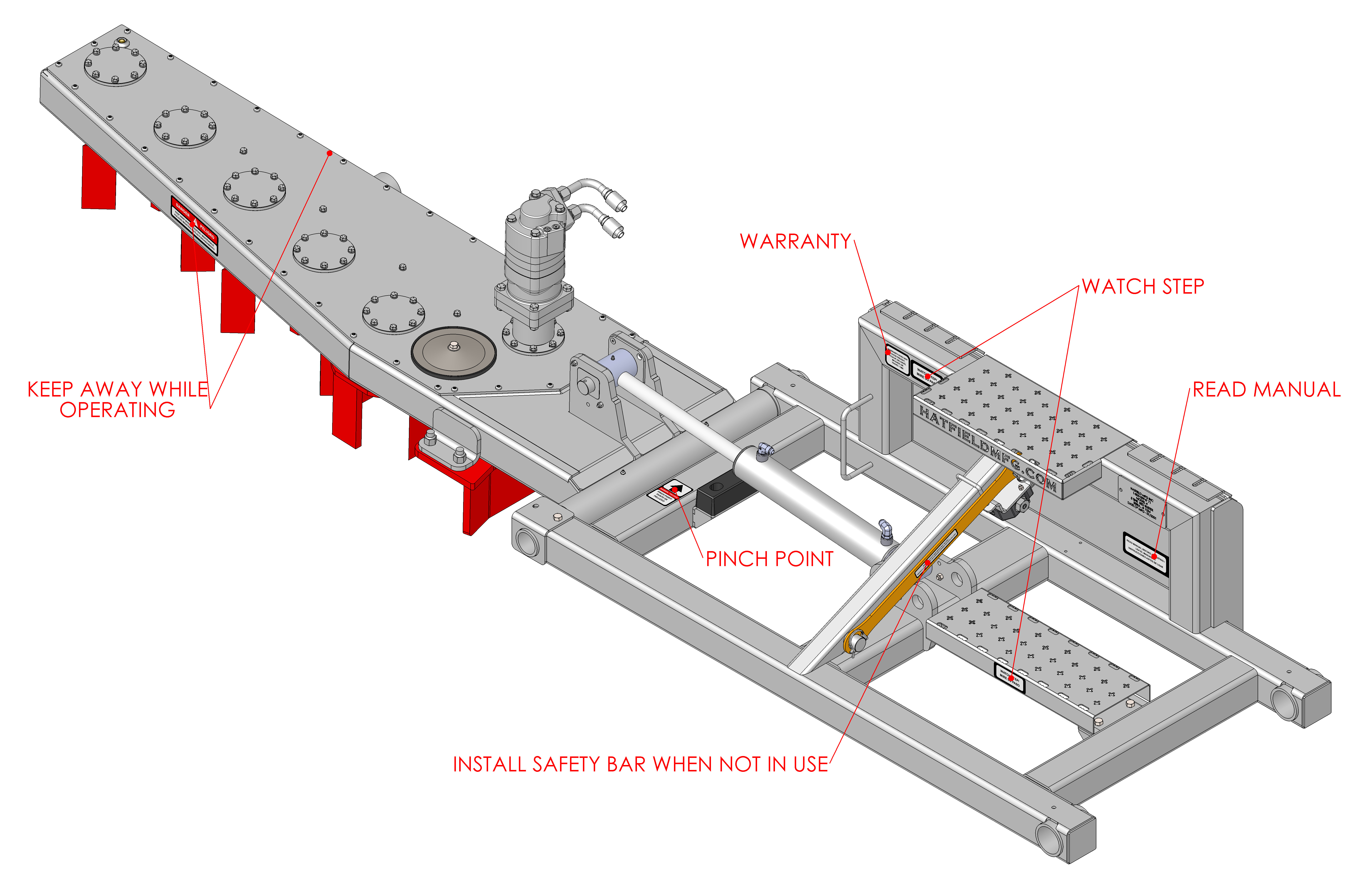
Labels for your Bed Buster are sold in packages containing all the safety labels you need.
Record your machine details: Serial Number, Model Number and Delivery Date. The Serial Number and Model Number can be found by referencing the picture below.
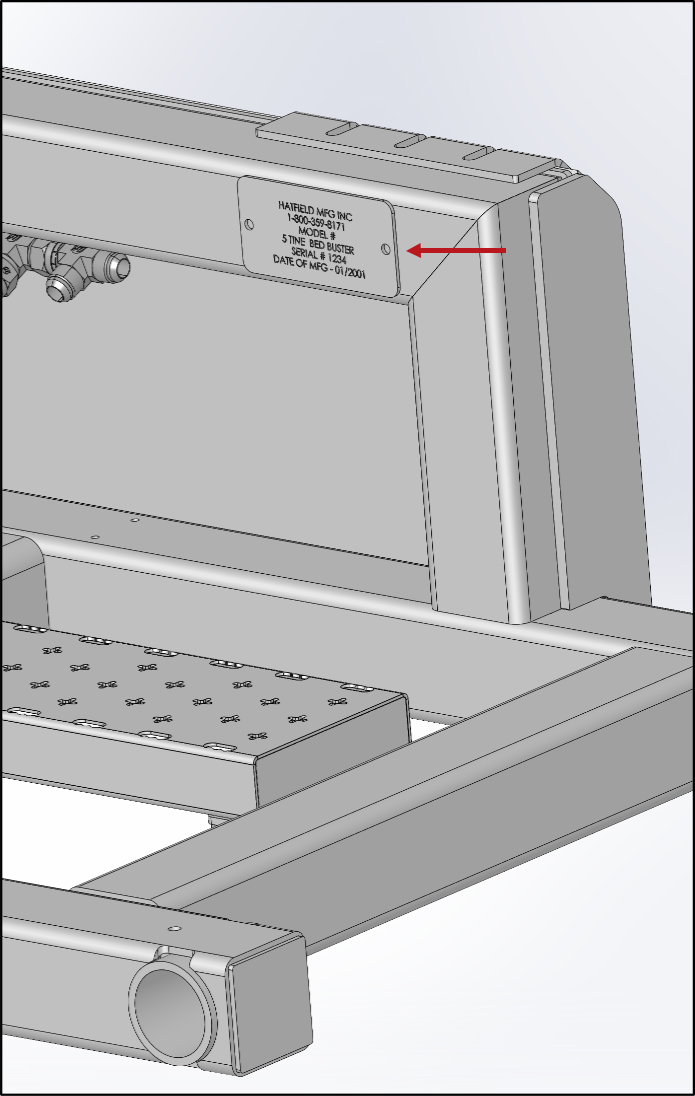
Introduction
Hatfield Manufacturing designed this tiller with care and built it with skilled workers using quality materials. Proper maintenance and safe operating practices will help you get years of satisfactory use.
Application
Bed Busters are designed and built by Hatfield Manufacturing to till bedding in Freestall beds consisting of sand, dirt, and/or compost.
Using this Manual
- This Operator’s Manual is designed to help familiarize you with safety, operation, adjustments, troubleshooting, and maintenance. Read this manual and follow the recommendations to help ensure safe and efficient operation.
- The information contained within this manual was current at the time of printing. Some parts may change slightly to assure you of the best performance.
- To order a new Operator’s or Parts Manual, visit our website at www.hatfieldmfg.com.
Terminology
- “Right” or “Left” as used in this manual is determined based on the operator sitting in the power machine facing forward.
- “Clockwise” or “Counterclockwise” as used in this manual is determined based on the operator facing forward, seated on the power machine, looking down “through” the implement, or looking to the Right.
- “Standard” or “Reverse” as used in this manual in reference to Tines means the direction the tine is meant to spin. Standard is Clockwise, Reverse is Counterclockwise.
Owner Assistance
- The parts on your Bed Buster have been specially designed by Hatfield Manufacturing and should only be replaced with genuine Hatfield Parts. Contact us if customer service or repair parts are required.
Serial Number
- For quick reference and prompt service, record the serial and model number. Always provide the serial number when ordering parts and in all correspondences with Hatfield Mfg., or the Dealer you purchased your Bed Buster from. Your Serial Number can be located on your machine by referencing the picture below.
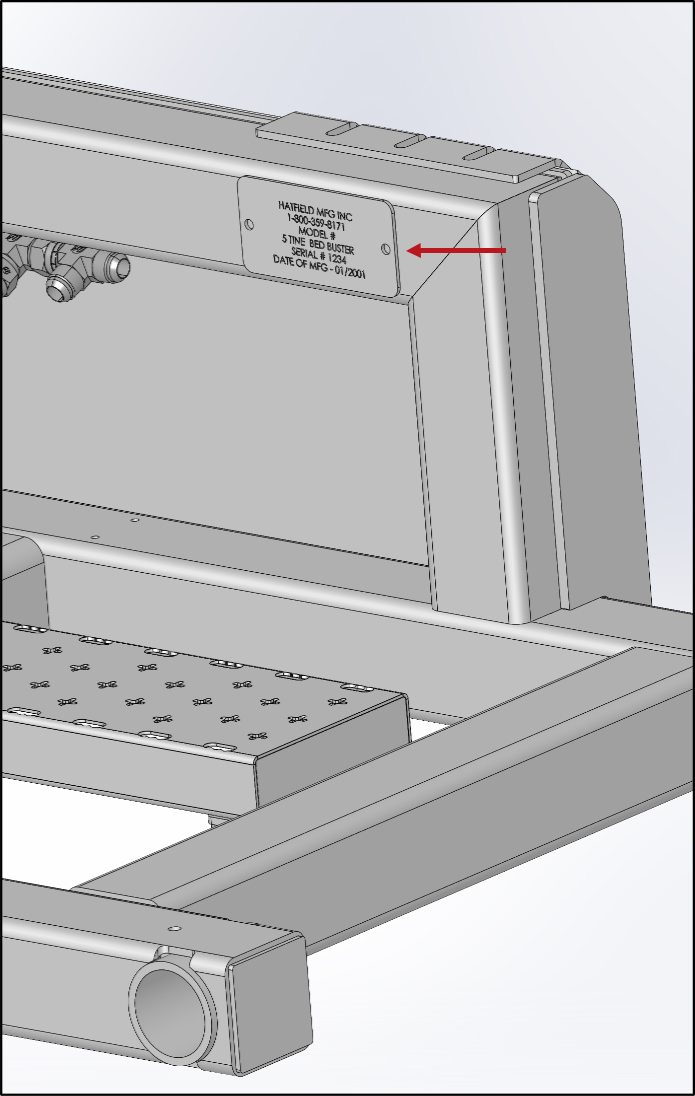
Preparation and Installation
Your Bed Buster comes shipped with a yellow Storage Bar. The Storage Bar must be removed and stowed in its storage location prior to use.
The Storage Bar should always be reinstalled when the implement is not in use for safety.
Power Machine Requirements
| Flow | Pressure | |
|---|---|---|
| Minimum | 18 GPM (68 LPM) | |
| Recommended | 22 GPM (83 LPM) | |
| Maximum | 30 GPM (114 LPM) | 3000 PSI |
- Bed Busters come standard with Skid Steer Quick Attach (SSQA) plates. The SSQA fits almost all skid steers of any brand and other mini loaders and small power machines that have either a manual lever or hydraulically activated SSQA systems. Bed Busters can optionally be ordered with other Quick attach systems on them. The Bed Buster also requires the power machine to provide Hydraulic oil under pressured flow through an auxiliary hydraulic or hydraulic remote. Flows and pressures must be as noted below.
- We ship Bed Busters with the most common flat faced quick connects installed on the hoses. If they do not fit your power machine you will need to change them. Contact us if you are having trouble sourcing or identifying the quick connects you need.
- The first time you hook up your Bed Buster to a new power machine, ensure that the controls function as desired. If they seem “backwards” we recommend you swap the auxiliary hydraulic ports that the Bed Buster is hooked up to on your power machine.
Facility Requirements
- Prior to using your Bed Buster, you need to ensure that the location to be tilled has room for the Bed Buster arm to travel under any installed fixtures (ie. Freestall Loops). Also, ensure that nothing else is going to collide with any part of the Bed Buster or the Power Machine as they progress through the tilling project.
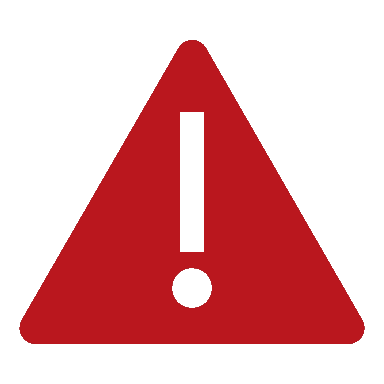
DANGER
To avoid serious injury or death:
- A crushing hazard exists while connecting and disconnecting the implement. Keep people and animals away while pulling up to or away from the implement. Do not operate hydraulic controls while a person or animal is near the power machine or implement.
- Power machines and implements can cause structural damage to facilities and unsafe conditions very quickly when operated incorrectly or carelessly. Do not allow anyone to operate this equipment that has not read and understands the Operating manuals or is not properly trained.
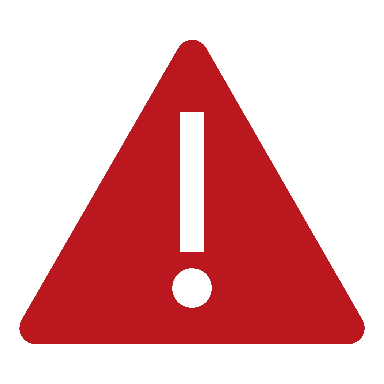
WARNING
To avoid serious injury or death:
- An unsupported Bed Buster can tip over. Always use the safety bar to keep the arm in the upright position unless storing in the extended position.
- Always follow “Power Machine Shutdown Procedure” provided in this manual before dismounting the Power Machine.
- When attaching your Bed Buster to your Power Machine for the first time make sure the Quick Attach matches and properly engages. Refer to your Power Machine’s Owners’ Manual or Quick Attach Owner’s manual and follow all procedures and safety guidelines available there as well as in this manual.
General Operating Instructions
Inspect the following items before each operating session with the power machine attached and powered off:
Operating Checklist
- Ensure that the Bed Buster is securely attached to the Power Machine and that the hooks and pins are in good repair and fully engaged.
- Refer to your Power Machines manual and make sure it is in good repair and functioning properly.
- Check oil level in the Bed Buster arm using the rear sight glass. Refer to Arm Oil Fill/Replacement in Maintenance tab.
- Check that all plugs are in place and there are no leaks in the hydraulic lines or fittings.
- Be certain that all tiller tines, bolts and nuts are tight.
- Check for in the drive chain. Refer to Chain Tensioning in Maintenance tab.
- Check for worn, bent, loose or broken tines. Refer to Tine replacement in Maintenance tab.
- Make sure the curb guide is in good condition, in place and secured. Refer to Curb Guide Replacement in Maintenance tab.
- Examine the bottom of the arm for leaks or damage. Refer to Seal replacement in Maintenance tab.
- Check that any optional equipment is in good repair and properly secured.
- Check initially and periodically for loose bolts and pins. Refer to Torque Values tab.
- Ensure all grease points have been greased according to the maintenance schedule. See Lubrication Points in Maintenance tab.
- Clear area to be tilled of rocks and other foreign objects.
Power Machine Startup Procedure
The following are basic power machine startup and operating procedures.
- Enter skid steer and apply all safety measures (seat belt, draw bar, etc.)
- Turn on auxillary pump.
- Start machine and set Rev between 75-100%.
- Align with beds and let arm down. Ensure tines are spinning properly.
- Ensure arm is level with the bed, both front to back and side to side, and curb guide is touching the curb.
- Slowly lower the arm into the area to be tilled. The arm lowers with the same control as the tines rotate. Lowering the arm slowly keeps the tines from rotating prematurely, but it also is generally a safer practice.
- At first begin tilling at a slow forward speed and don’t speed up unless bed conditions permit. Groom beds between 1-4 mph.
- Keep the curb guide against the outside of the curb in Freestall beds. IMPORTANT: Failure to keep the curb guide against the outside of the curb can allow the nearest tine to contact the inside of the curb as it spins. This can damage the curb and the machine.
- As you progress forward in the Freestalls, make sure you keep the tiller arm below the loops. IMPORTANT: Care must be taken to ensure the all of the components of the Bed Buster and the Power machine stay clear of the stationary components of the facility.
- When finished tilling, lift arm and replace safety arm.

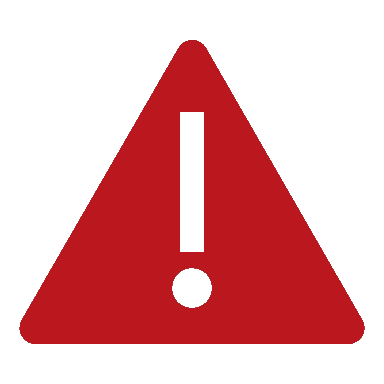
DANGER
To avoid serious injury or death:
- Keep yourself and all others away from rotating tines. Always disengage power take-off and lockout power source before making adjustments or servicing the implement. A person’s body, hair, or clothing can become entangled in rotating components causing serious bodily injury or death.
- All guards and shields must be installed and in good working condition while operating the implement.
- Tine impact on objects can throw projectiles resulting in bodily injury or death. Do not point discharge toward people, animals, or buildings and keep people and animals away from tiller during operation.
- Never make contact with underground utilities such as electrical power lines, gas lines, phone lines, etc. They can cause serious injury or death from electrocution, explosion, or fire. Always call 811 (USA) before digging so that they can mark the location of underground services in the area. For contact information, see Dig Safe in the Important Safety Information 2 tab.
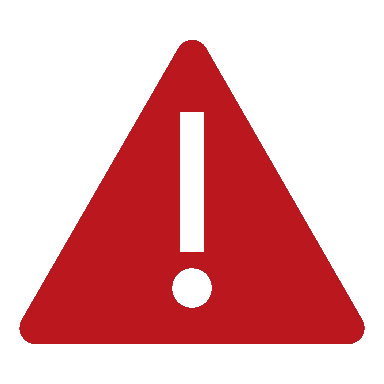
WARNING
To avoid serious injury or death:
- Allow only persons to operate this implement who have fully read and comprehended this manual, and who have been properly trained in the safe operation of this implement. Serious injury or death can result from the inability to read, understand, and follow instructions provided in this manual.
- Always follow “Power Machine Shutdown Procedure” provided in this manual before dismounting the power machine.
- Never carry riders on the implement or tractor. Riders can obstruct the operator’s view, interfere with controls, be pinched by moving components, become entangled in rotating components, struck by objects, thrown about, fall off and be run over, etc.
- Perform scheduled maintenance. Check for loose hardware, missing parts, broken parts, structural cracks, and excessive wear. Make repairs before putting the implement back into service.
- Do not till across steep inclines that are subject to rollover. The action of the tines being forced down into the ground can cause the power machine to roll-over resulting in serious injury or death. Consult your power machine’s manual for acceptable inclines that the power machine is capable of traveling across.
- Be careful when working areas where obstructions can be hidden. Always mark potential hazards with a visible flag. Travel slowly through high-risk areas and be prepared to stop immediately should implement make contact with a solid object.
- Do not use implement for a purpose other than the work it is designed to do as defined in this manual.
- Do not use implement as a man lift, work platform or as a wagon to carry objects. It is not properly designed or guarded for this use.
- Do not use implement to lift objects; to pull objects such as fence posts, stumps, etc.; or to push objects. The unit is not designed or guarded for these uses.
- Do not use implement to tow other equipment unless it is designed with a tow hitch. Doing so can result in loss of control and damage the equipment.
- Do not alter implement or replace parts on the implement with other brands. Other brands may not fit properly or meet OEM (Original Equipment Manufacturer) specifications. They can weaken the integrity and impair the safety, function, performance, and life of the implement. Replace parts only with genuine OEM parts.
- Avoid exposure to dust containing crystalline silica particles. This dust can cause serious injury to the lungs (silicosis). Because crystalline silica is a basic component of sand and granite, many activities at construction sites produce dust containing crystalline silica. Trenching, sawing, and boring of material containing crystalline silica can produce dust containing crystalline silica.
Power Machine Shutdown Procedure
The following are basic power machine shutdown procedures. Follow these procedures and any additional shutdown procedures provided in your Power Machine Operator’s Manual before leaving the Operator’s station.
- The Bed Buster arm should be in the fully upright position.
- Ensure that the arm is lowered all the way in an area where it won’t pose a danger.
- Shutdown the Power Machine, remove the key to prevent unauthorized or untrained individuals from starting the power machine and exit the operator’s station.
- Install the shipping and storage bar on the cylinder pins and lock it in place using the lynch pins.
- It is recommended, to leave the Bed Buster attached to the power machine when not in use, if possible.
Maintenance
Keeping your implements and equipment clean and maintained will make them safer and help them last longer. This section contains information you need to help keep your Bed Buster running.
Scheduled Maintenance
This Maintenance Schedule should be used as a basis for creating your own Schedule. These should be viewed as minimum intervals. Based on your implement usage some or all maintenance items may need to be addressed more frequently.
Lubrication Points
There are four (4) grease zerk fittings on the implement. One at each end of the arm’s hydraulic cylinder and two in the top of the arm’s hinge. These points must be greased with high quality multipurpose grease every 50 operating hours.
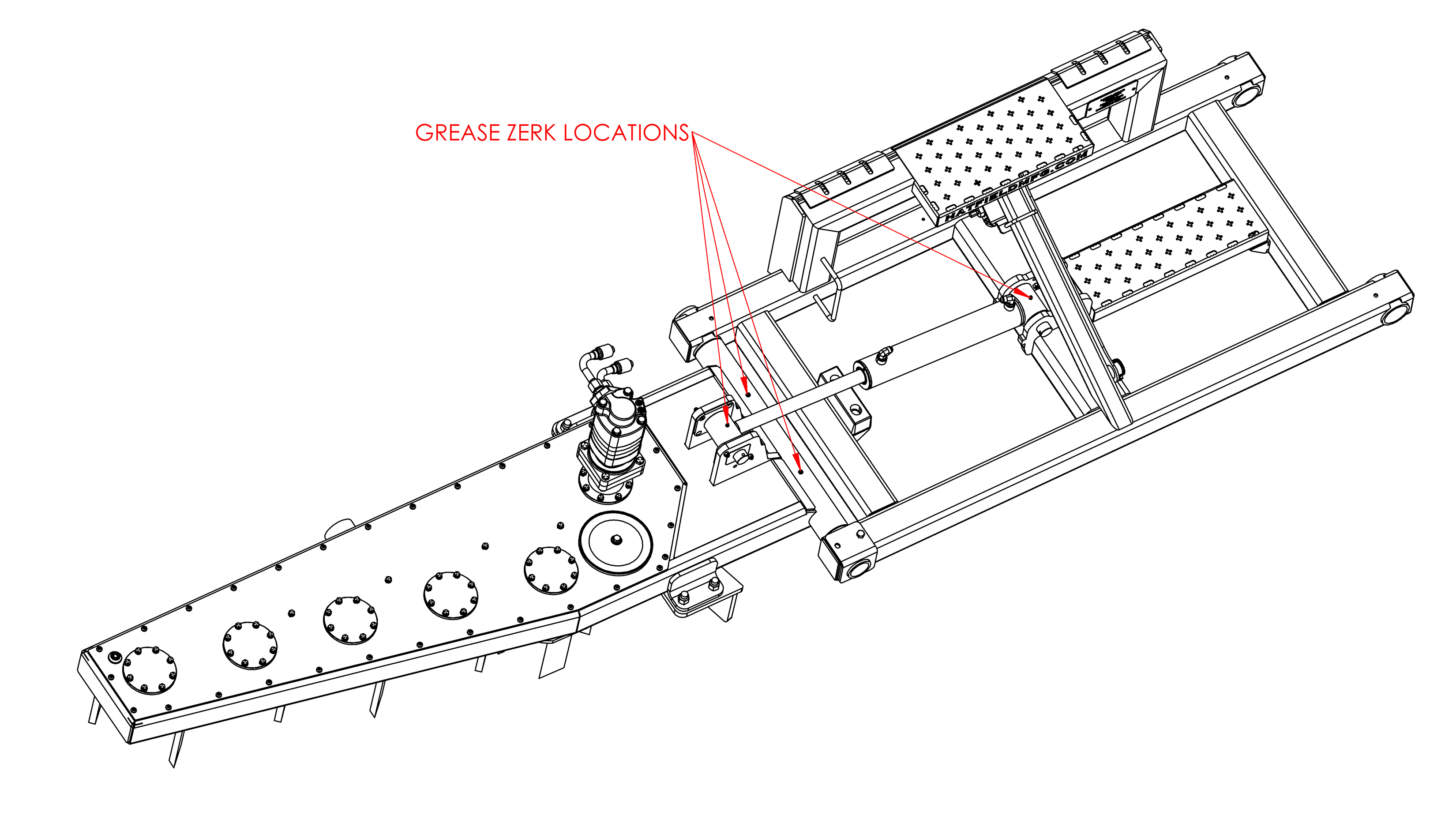
Arm Oil FIll/Replacement
The arm of the Bed Buster is filled with 80/90 weight oil, the arm should be filled to the sight glass. This can be checked with the arm in the vertical or horizontal position. This must be checked daily. Oil should not need to be added regularly. If oil is regularly low, check for leaks at the tine seals and or the lid and cap locations.

Chain Tensioning
Chain tension should be checked every 100 operating hours To check the chain tension:
- Lower the arm to as level as possible.
- Remove the cleanout cover.
- Check the tension.
If more tension is needed:
- Loosen the bolt on the idler sprocket
- Use an alignment bar or pry bar to push the idler sprocket deeper into the chain engagement.
- Retighten the bolt on the idler sprocket
- Replace the cleanout cover.
Tine Replacement
There are two types of times, standard (clockwise while looking down on them in the freestall beds. On the 5 tine Bed Busters these are in the 1st, 3rd, and 5th position. Reverse (counterclockwise while looking down on them), these are in the 2nd and 4th position on the 5 tine Bed Buster. The 3 tine Bed Buster only has standard tines. In order to replace a tine:
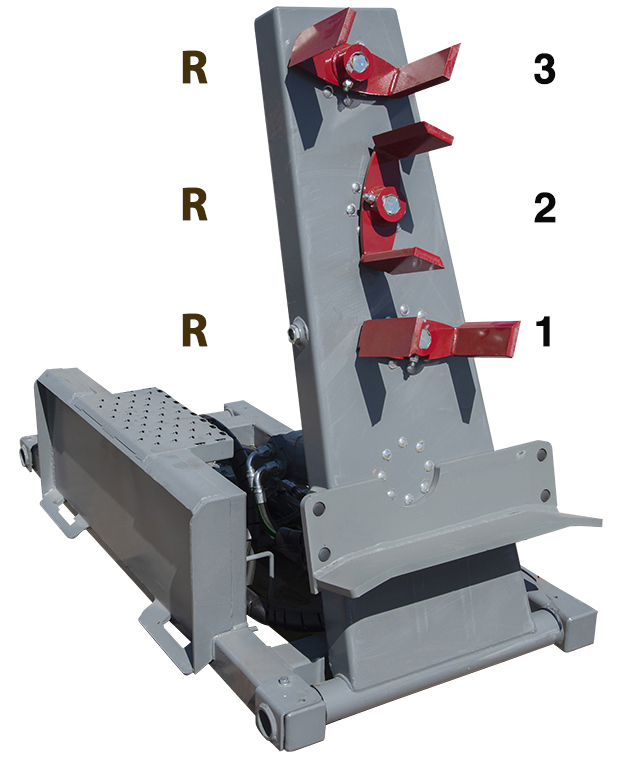
Compact Bed Buster
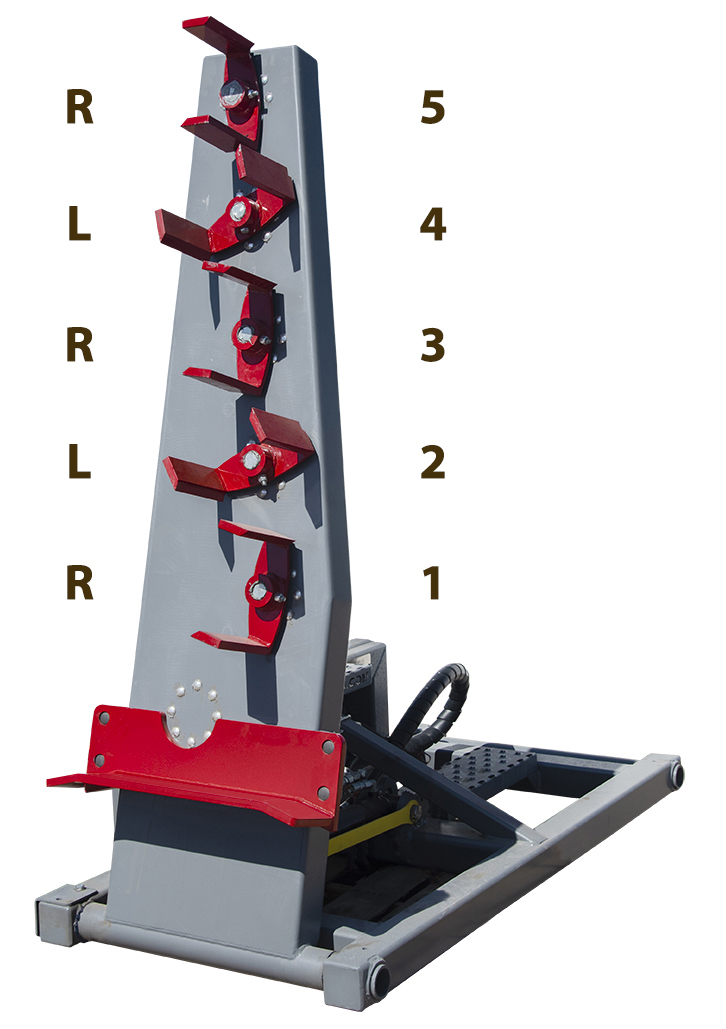
Standard Bed Buster
- Make sure that the replacement tine is the correct tine rotation by comparing it to the old tine if possible or referring to the diagram.
- Follow the Power Machine Shutdown procedure.
- Remove the crossbolt on the tine to be replaced.
- Sometimes, damage to the end of the tine shaft or debris can keep the tine from releasing from the shaft, you may have to tap the tine with a hammer to get it to release.
- Once the tine is removed, take time to inspect the tine shaft and seals. Also, remove any material or debris that is wrapped around the tine shaft and clean up the end of the shaft and file or flap wheel can be used to remove any mushrooming or damage to the bottom edge.
- A small amount of grease or anti-seize added to the tine shaft before installing the new tine may help future replacements
- Install the new tine and secure with a new cross bolt and nylock nut and torque to spec.
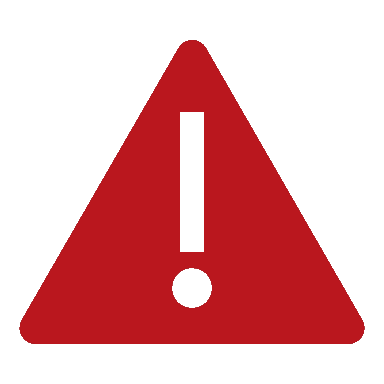
WARNING
To avoid serious injury or death:
Curb Guide Replacement
The Curb Guide is made of abrasion resistant steel and serves 2 purposes: Keeping the machine correctly aligned to the freestall bed while also protecting the tiller arm from grinding on the curb.
Troubleshooting
| Problem | Cause | Solution |
|---|---|---|
| Tines aren''t turning. | Power machine is not providing hydraulic pressure | Check oil level in power machine. Check oil pressure coming from power machine. |
| Tines aren''t turning. | Hoses aren’t fully engaged to the power machine. | Check that fittings are correct and engage them fully. |
| Tines aren''t turning. | Motor Coupling is broken. | Replace motor coupling. |
| Tines aren''t turning. | Chain is broken. | Replace chain. |
| Tines aren''t turning. | Motor is worn out. | Replace motor. |
| Depth of tilling is shallow. | Tines are worn. | Replace tines. |
| Machine is making grinding sounds or is noisier than normal. | Oil is low / empty. | Fill or change oil. |
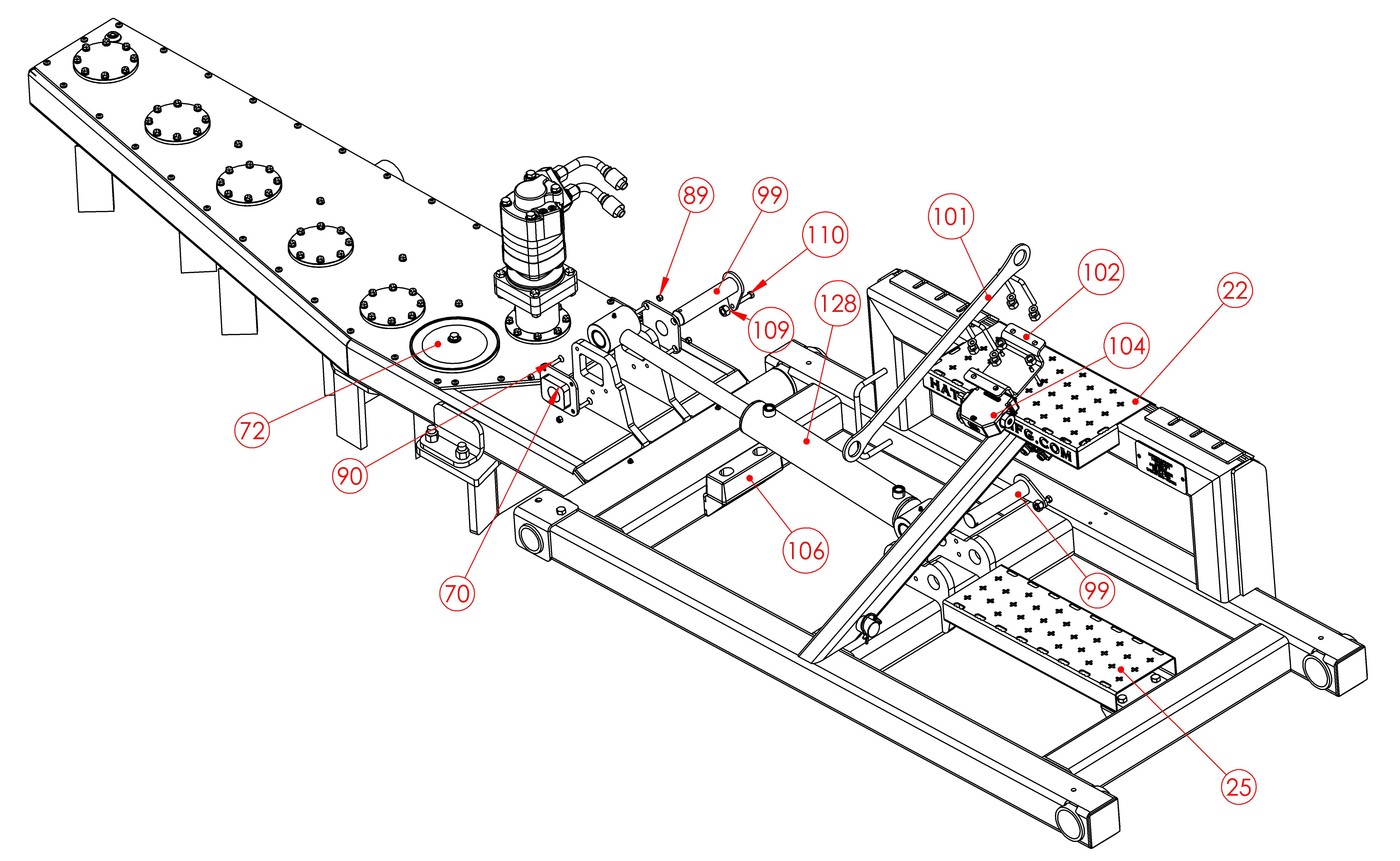
| Part | Quantity | Description | Part Number |
|---|---|---|---|
| 22 | 1 | VTFT Frame, Skid Steer, Step | 420-3553 |
| 25 | 1 | VTFT Frame, Skid Steer, Lower Step, Tread | 420-3554 |
| 70 | 2 | VTFT, Ram Mount, Indexing Block | 420-3053 |
| 72 | 1 | Cleanout Cover, 8 inch | FCC-8 |
| 89 | 4 | Nylon Lock Nut 5/16" - 18, Grade 5 Zinc | NN516-18-G5ZN |
| 90 | 4 | Socket Countersunk Head Cap Screw, 5/16"-18 X 1-1/2", Grade 5 Zinc | SCHCS516-18-112-G5ZN |
| 99 | 2 | VTFT, Retainer Pin | 420-3056 |
| 101 | 1 | VTFT, Ram Mount, Safety Bar | 420.3058 |
| 102 | 1 | VTFT, Sequence Valve Bracket | 420-3059 |
| 104 | 1 | Sequence Valve | RD-1012-SM |
| 106 | 1 | Vehicle Mount Bumper | 21685T11 |
| 109 | 1 | Nylon Insert Locknuts, 3/8"-16, Grade 5 Zinc | NN38-16-G5ZN |
| 110 | 1 | Nylon Insert Locknuts, 3/8"-16, Grade 5 Zinc | HB38-16-2-G5ZN |
| 128 | 1 | Hydraulic Cylinder | 101-4316 |
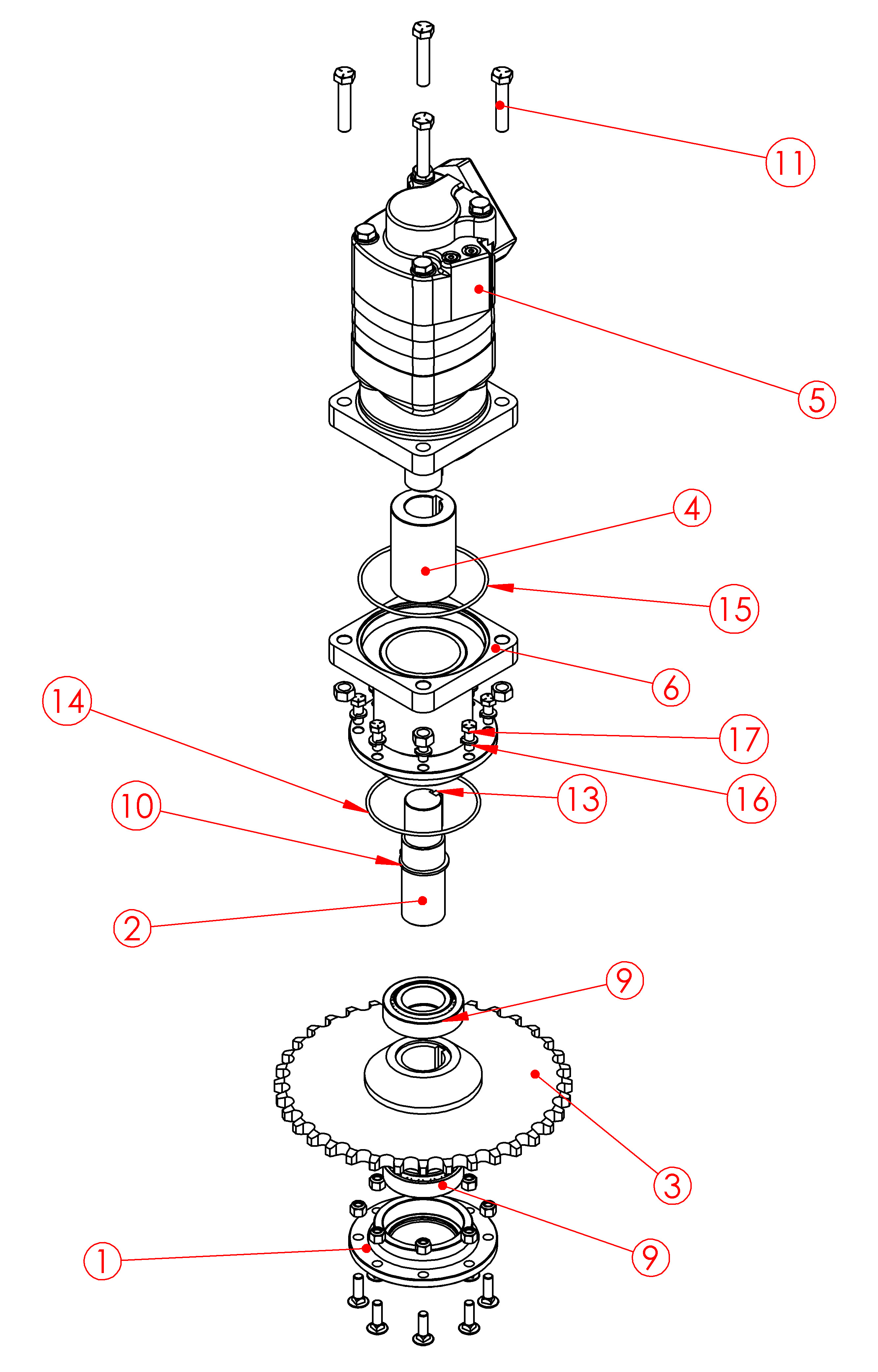
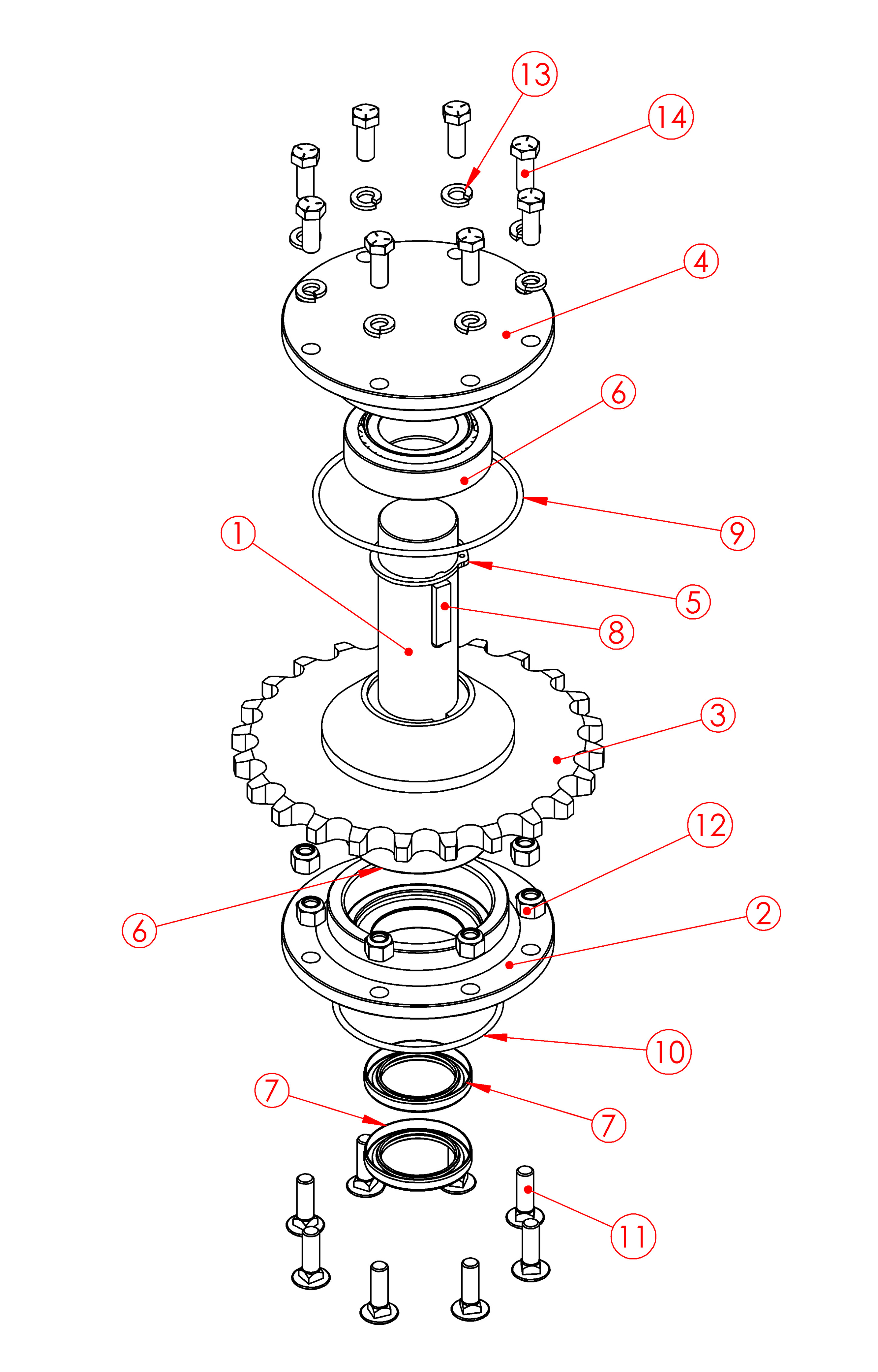
| Part | Quantity | Description | Part Number |
|---|---|---|---|
| 1 | 1 | VTFT, Drive Bearing Pack, Bottom | 420-3250 |
| 2 | 1 | VTFT, Drive Bearing Pack, Shaft | 420-3252 |
| 3 | 1 | VTFT, Drive Bearing Pack, 36 Tooth Sprocket | 420-3253 |
| 4 | 1 | 1.50 Inch Rigid Shaft Coupler with Keyway, No Set Screws | DR-9133-006 |
| 5 | 1 | Bed Buster Drive Motor | 112-1068-006 |
| 6 | 1 | VTFT, Drive Motor Mount Plate | 420-2105 |
| 9 | 2 | Tapered Roller Bearing & Race, 1.75 Inch ID | 25580-25520 |
| 10 | 1 | Retaining Ring, 7200-100-100-500 | R-C-SHR-175ST-PD |
| 11 | 4 | Hex Bolt, 1/2"-13 x 2-1/2, Grade 5 Zinc | HB12-13-212-GSZN |
| 13 | 2 | Machine Key, 3/8" x 3/8" x 1 9/16", Carbon Steel | MK38-1916-CS |
| 14 | 1 | O-Ring, N70-2-245 | O-R-8245-N |
| 15 | 1 | O-Ring, N70-2-250 | O-R-8238-N |
| 16 | 8 | Split Ring Lock Washer, 3/8", Zinc | SLW38-W |
| 17 | 8 | Hex Bolt, 3/8" - 16 x 1", Grade 5 Zinc | HB38-16-1-G5ZN |
| Part | Quantity | Description | Part Number |
|---|---|---|---|
| 1 | 1 | VTFT, Tiller Bearing Pack, Shaft | 420-3202 |
| 2 | 1 | VTFT, Tiller Bearing Pack, Bottom | 420-3200 |
| 3 | 1 | VTFT, Tiller Bearing Pack, 24 Tooth Sprocket | 420-3203 |
| 4 | 1 | VTFT, Tiller Bearing Pack, Top | 420-3201 |
| 5 | 1 | Retaining Ring, 7200-100-100-500 | R-C-SHR-175ST-PD |
| 6 | 2 | Tapered Roller Bearing & Race, 1.750 Inch ID | 25580-25520 |
| 7 | 2 | Grease Seal, 175233B | DRS - 175233B |
| 8 | 1 | Machine Key, 3/8" X 3/8" X 1-9/16", Carbon Steel | MK38-1916-CS |
| 9 | 1 | O-Ring, N70-2-245 | O-R-8245-N |
| 10 | 1 | O-Ring, N70-2-238 | O-R-8238-N |
| 11 | 8 | Carriage Bolt, 3/8" -16 X 1-1/4", Grade 5 Zinc | CB38-16-114-G5ZN |
| 12 | 8 | Nylon Lock Nut, 3/8"-16, Grade 5 Zinc | NN38-16-G5ZN |
| 13 | 8 | Split Ring Lock Washer 3/8", Zinc | SLW38-W |
| 14 | 8 | Hex Bolt 3/8"-16 X 1", Grade 5 Zinc | HB38-16-1-G5ZN |
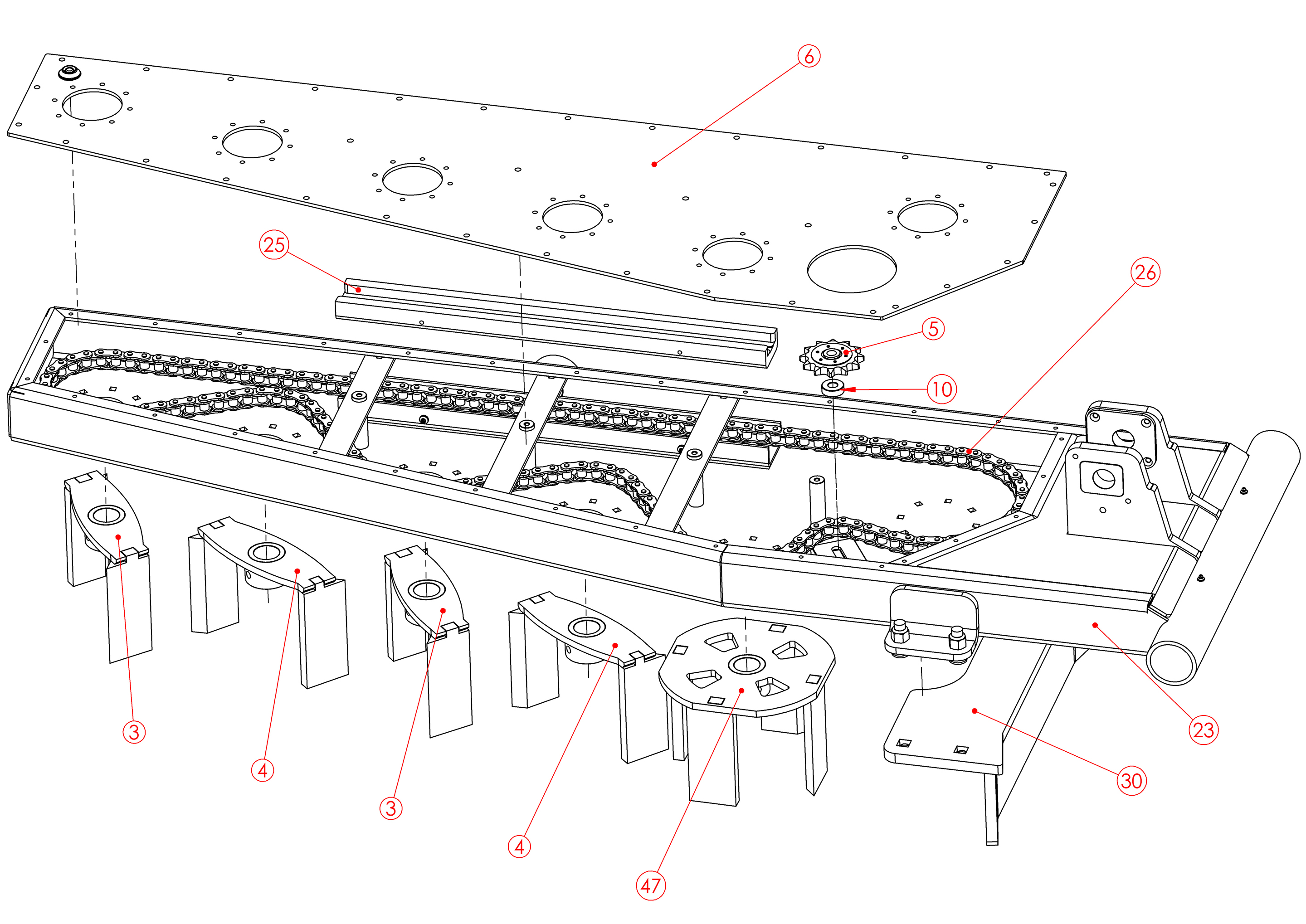
| Part | Quantity | Description | Part Number |
|---|---|---|---|
| 3 | 2 | VTFT, Clockwise Tine Assembly | 420-2101 |
| 4 | 2 | VTFT, Counterclockwise Tine Assembly | 420-2102 |
| 5 | 1 | #80 Chain 12 Tooth, .625 Bore, Idler Sprocket | SPK-704 |
| 6 | 1 | VTFT Arm, Pan LID | 420-3050 |
| 10 | 1 | VTFT, Tensioner, Spacer | 420-3051 |
| 23 | 1 | VTFT Arm, Pan Body, Right | 420-3000 |
| 25 | 1 | VTFT, Chain Guide, UHMW | 420-3052 |
| 26 | 1 | Lynx #80 Roller Chain, 159 Pitches + C/L | LNX-80RIV-159P+C-L |
| 30 | 1 | VTFT, Curb Guide | 420-2100 |
| 47 | 1 | VTFT, Curb Tine Assembly | 420-2221 |
Accessories - Curb Scrape Kit
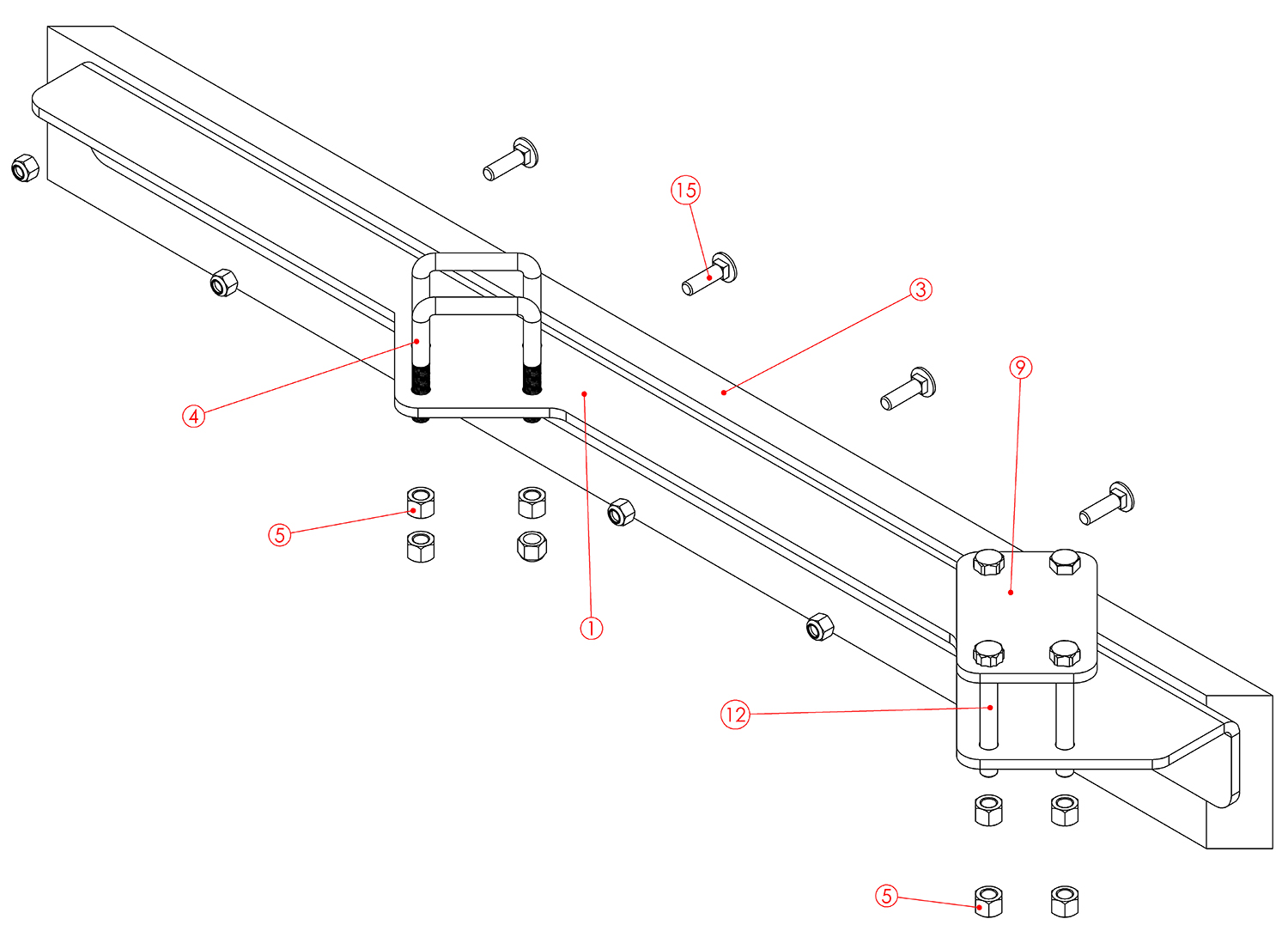
| Part | Quantity | Description | Part Number |
|---|---|---|---|
| 1 | 1 | VTFT, Curb Scrape Kit, Bracket | 420-3700 |
| 3 | 1 | VTFT, Curb Scrape Kit, UHMW Blade | 420-3702 |
| 4 | 2 | U-Bolt 4" x 5.50" x 3/4" - 16 | 420-3707 |
| 5 | 8 | Nylon Insert Locknuts, 3/8"-16, Grade 5 Zinc | NN34-16-G5ZN |
| 9 | 1 | Alley Scrape Kit, Rear Bolt Plate | 420-3705 |
| 12 | 4 | Hex Bolt, 3/4"-10 x 6", Grade 5 Zinc | HB34-10-6-G5ZN |
| 15 | 6 | Carriage Bolt 5/8" -11 x 2-1/4", Grade 5 Zinc | CB58-11-214-G5ZN |
Main Office & Manufacturing
1823 Shoestring Road | Gooding, Idaho 83330 | Toll Free: 800.359.8171 | 208.934.5182 | Fax: 208.934.8892
Sales | Parts | Manuals | Financing | Our Company | Contact Us
2025 Hatfield Manufacturing, Inc.
